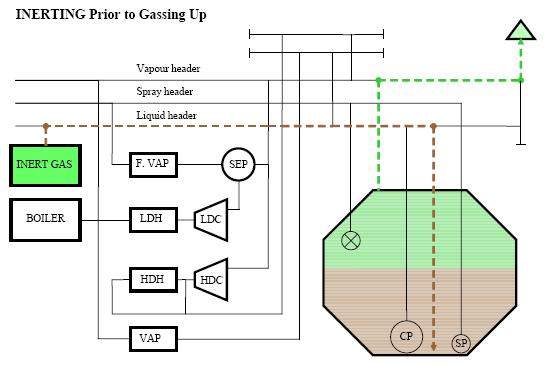

Home page|||
LNG handling |||
LPG handling||| Other Gas products|||
Fire & Safety|||
Emergency response |||
Preparation for loading LNG cargo - Inerting of cargo tanks
Inert gas (e.g. nitrogen) or mixture of gases, containing insufficient oxygen to support combustion.The introduction of inert gas into a space to reduce and maintain the oxygen content at a level at which
combustion cannot be supported- with an Oxygen content of less than 1% and a dewpoint of less than -45 deg C is typically
introduced into the bottom of cargo tank through the filling pipe.
The Inert Gas is displaced from
the top of each tank through the dome and vapour header and is discharged from the vent mast.
During this process all the cargo piping and equipment forming part of the cargo system is to be
purged with Inert Gas.
Warning - Inert Gas will not sustain life. Great care is to be taken to ensure the safety of all
personnel involved with any part of the operation including those working with the Inert Gas plant.
Below is our guideline prior loading LNG cargo on board:
Inerting of Cargo Tanks:
Vapours from the last cargo in the system are displaced by inert gas from the ship’s inert gas generator, or by pure nitrogen from shore. If the ship’s inert gas is used, the cargo piping system from the tank should be opened to the vent before the inert gas supply is connected as an additional precaution against the possible backflow of flammable vapour to the generator.
Regulations regarding venting of cargo vapour in port should be observed. Such regulations may require that vented cargo vapours should be led to a flare or vent stack ashore. Inerting is continued until the required dew point or concentration of cargo vapour or oxygen level has been reached.
Before introducing the cargo into the tanks, the moisture content and oxygen content in the tanks shall be reduced simultaneously.
Cargo tanks filled with air shall be dried and inerted with inert gas supplied from the inert gas generator on board. Inert gas shall be led into the bottom of the cargo tank through the liquid filling line and displaced air shall be vented to the atmosphere through the vapour line and the vent mast.
Drying and inerting shall be finished when the dew point and also the oxygen content in the cargo tank are less than the planned level.
The dew point and oxygen content shall be periodically measure by a portable instrument at the sampling lines in way of cargo tank dome.

Fig:Inerting prior to gassing up
Inerting of Annular Space for Moss type vessels
The space between the surface of a cargo tank and insulation is called annular space, insulation space or wedge space. Annular Space is inerted with nitrogen gas and continuously supplied from N2 generator through the N2 bleed line in service in order to ensure adequate path in the insulation space for the gas detection system.
A safety valve is installed in the N2 bleeding line of each hold in order to avoid over pressure of the insulation space.
Inerting Inter Barrier Spaces (IBS) and Insulation Spaces (IS) for Membrane type vessels
The space between the primary and the secondary barrier is called inter-barrier space (IBS). The space between the secondary barrier and the inner hull is called insulation space (IS). The pressure in these spaces shall be regulated at a pressure slightly above atmospheric pressure in order to prevent any air ingress.
In normal operation, IBS and IS shall be purged with nitrogen in relation with atmospheric pressure variations and cooling or warming of the spaces during loading or unloading, and IBS should be continuously purged with nitrogen if gas is detected by micro-leakage of the membrane.
The Nitrogen provides a dry and inert medium for the following purposes:
i) To prevent formation of flammable mixture in the event of any LNG leak.
ii) To permit easy detection of an LNG leak through a barrier
iii) To prevent corrosion
In addition each space shall be protected against over pressure by two (2) pilot operated safety valves.
During cargo loaded, as normal procedure, maintain the IBS pressure at or below cargo tank pressure and maintain the IS pressure at or above the IBS pressure.
Realted guideline for handling LNG cargo:
Drying of Cargo Tanks and preparation for loading LNG cargo
Gassing-up requirement for cargo tanks
Initial Cool Down of cargo tanks
Details of various cargo handling equipment onboard
Procedure for Changing Liquefied Gas Cargoes
Procedure for Liquefied Gas Cargo stripping
Displacing with Vapour of the Next Cargo (Purging)
Procedure for Water washing after Ammonia Cargoes
Use of cargo as fuel -Cargo conditioning, reliquefaction and boil-off control for LNG carriers

// Home page///
LNG handling ///
LPG handling///
Sea transport ///
Gas products///
Cargo work
///Fire precautions
///Health hazards
///Safety Precautions
///Emergency response ///

Copyright © Liquefied Gas Carrie.com All rights reserved.
The content published in this website are for general reference only. We have endeavoured to make the information
as accurate as possible but cannot take responsibility for any errors. For latest information please visit www.imo.org .
Any suggestions, please Contact us !
///Links &Resources //
Terms of use///
Privacy policy///Home page///
